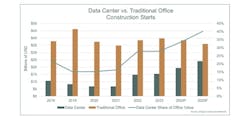How do you paint a rosy picture for a construction market sector that’s been in the dumps and shows scant signs of a quick change of fortune? There's one way: Stretch the definition, and throw in a category that’s come so far so fast that standard market indices haven’t been able to catch up.
That’s what FMI Corp., does in the second-quarter installment of its 2025 North American Engineering and Construction Industry Outlook. Reasonably, it lumps data centers into the office component of its non-residential construction analysis, yielding a bullish four-year forecast for the sector that beats nine of 10 others.
FMI notes that construction of offices designed for people may be due for a turnaround. But make no mistake — it's office structures housing banks of servers, storage, and networking hardware that will drive the growth of the sector, as FMI defines it.
Citing forecasts of data center demand growing 34% in 2025 and 18% next year, FMI sees office construction growing every year between 2026 and 2029 at an average of about 7% annually. Data center construction will ramp up, it says, despite challenges “including power shortages and long lead times for electrical infrastructure — factors that continue to disrupt both current and planned developments.”
Those headwinds are real, dictating in part where new data center construction is concentrating and how they’re designed and built. But it’s equally true that they’re not discouraging investment in new data center capacity needed to meet computing power demand driven by expectations for growing adoption for artificial intelligence.
Halfway through 2024 Dodge Construction Network posted an analysis showing data it collected pointed to a coming datacenter construction surge that would likely bleed into 2025. Data center projects, it said, were accounting for the lion’s share of commercial construction projects going into planning by mid-year 2024. Its Dodge Momentum Index that measures that activity was up 35% last July compared to July 2023 but would have been down 6% without datacenter projects.
“Strong demand for cloud and AI infrastructure is driving a lot of investment into the datacenter market — causing owners to push a slew of projects into the queue, especially as uncertainty wanes around 2025 market conditions,” the September 2024 blog post noted.
While data centers are being planned and built across the nation, activity may be strongest in areas where power is relatively abundant. Long lead times for connection to the grid are emerging as a major barrier to datacenter construction, leading developers to look to regions that offer a quicker path to that or even better prospects for developing on-site power generation, an emerging, but controversial trend.
Dodge notes that the South Atlantic region has been a hotbed of new activity, with Virginia, on its edge, emerging as the clear leader. Both Ohio and Texas are coming to the fore, sharing Virginia’s appeal for characteristics that may be important to data center developers, such as “the accessibility of power infrastructure, the lower cost or wider availability of land, or the competitive tax incentives offered by the states.”
“As artificial intelligence and cloud computing become a part of the everyday life of the average American, there will be no lack of demand for data centers moving forward,” Dodge says.
About the Author
Tom Zind
Freelance Writer
Zind is a freelance writer based in Lee’s Summit, Mo. He can be reached at [email protected].

